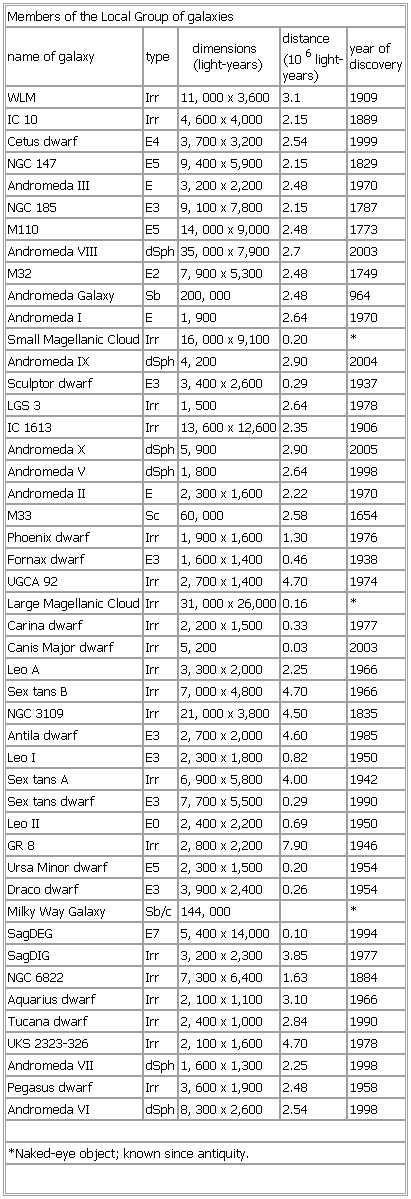- Members of the Local Group of galaxies
-
▪ TableMembers of the Local Group of galaxiesname of galaxy type dimensions(light-years) distance(106 light-years) year ofdiscoveryWLM Irr 11,000 x 3,600 3.1 1909IC 10 Irr 4,600 x 4,000 2.15 1889Cetus dwarf E4 3,700 x 3,200 2.54 1999NGC 147 E5 9,400 x 5,900 2.15 1829Andromeda III E 3,200 x 2,200 2.48 1970NGC 185 E3 9,100 x 7,800 2.15 1787M110 E5 14,000 x 9,000 2.48 1773Andromeda VIII dSph 35,000 x 7,900 2.7 2003M32 E2 7,900 x 5,300 2.48 1749Andromeda Galaxy Sb 200,000 2.48 964Andromeda I E 1,900 2.64 1970Small Magellanic Cloud (Magellanic Cloud) Irr 16,000 x 9,100 0.20 *Andromeda IX dSph 4,200 2.90 2004Sculptor dwarf E3 3,400 x 2,600 0.29 1937LGS 3 Irr 1,500 2.64 1978IC 1613 Irr 13,600 x 12,600 2.35 1906Andromeda X dSph 5,900 2.90 2005Andromeda V dSph 1,800 2.64 1998Andromeda II E 2,300 x 1,600 2.22 1970M33 Sc 60,000 2.58 1654Phoenix dwarf Irr 1,900 x 1,600 1.30 1976Fornax dwarf E3 1,600 x 1,400 0.46 1938UGCA 92 Irr 2,700 x 1,400 4.70 1974Large Magellanic Cloud (Magellanic Cloud) Irr 31,000 x 26,000 0.16 *Carina dwarf Irr 2,200 x 1,500 0.33 1977Canis Major dwarf Irr 5,200 0.03 2003Leo A Irr 3,300 x 2,000 2.25 1966Sextans B Irr 7,000 x 4,800 4.70 1966NGC 3109 Irr 21,000 x 3,800 4.50 1835Antila dwarf E3 2,700 x 2,000 4.60 1985Leo I E3 2,300 x 1,800 0.82 1950Sextans A Irr 6,900 x 5,800 4.00 1942Sextans dwarf E3 7,700 x 5,500 0.29 1990Leo II E0 2,400 x 2,200 0.69 1950GR 8 Irr 2,800 x 2,200 7.90 1946Ursa Minor dwarf E5 2,300 x 1,500 0.20 1954Draco dwarf E3 3,900 x 2,400 0.26 1954Milky Way Galaxy Sb/c 144,000 *SagDEG E7 5,400 x 14,000 0.10 1994SagDIG Irr 3,200 x 2,300 3.85 1977NGC 6822 Irr 7,300 x 6,400 1.63 1884Aquarius dwarf Irr 2,100 x 1,100 3.10 1966Tucana dwarf Irr 2,400 x 1,000 2.84 1990UKS 2323-326 Irr 2,100 x 1,600 4.70 1978Andromeda VII dSph 1,600 x 1,300 2.25 1998Pegasus dwarf Irr 3,600 x 1,900 2.48 1958Andromeda VI dSph 8,300 x 2,600 2.54 1998*Naked-eye object; known since antiquity.See as table:

* * *
Universalium. 2010.
